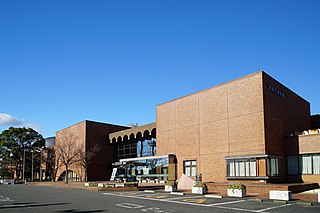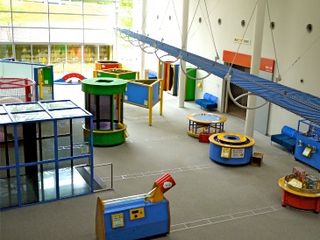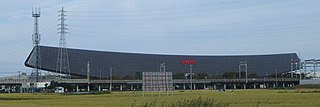 W
WChiba Museum of Science and Industry is a science museum located in Ichikawa, Chiba Prefecture, Japan. The museum introduces mainly topics related to technology, for modern industry. The museum sets up its goal as to provide a place for experiencing various aspects of science and technology which is applied in industry to people at all ages.
 W
WThe Electricity Museum is a technological museum and exhibition hall located in the city of Nagoya, Aichi Prefecture, Japan.
 W
WThe Gifu City Science Museum is a city-supported museum in Gifu, Gifu Prefecture, Japan. It was built in 1955 and was moved to its present location and renamed the Gifu City Children’s Science Center in 1980. When the planetarium was added in 1988, the name was again changed to the Gifu City Science Museum. There are many hands-on exhibits in the museum.
 W
WThe Hiroshima Children's Museum is a science museum for children in Hiroshima, Japan.
 W
WThe Hiroshima City Ebayama Museum of Meteorology was the first museum of meteorology in Japan. It is located in Ebayama Park in the city of Hiroshima, Hiroshima Prefecture, Japan.
 W
WThe Izumo Science Center is a science center located in Izumo-shi, Shimane Prefecture, Japan that operates both as a school and as a center for public education. The pupils in Izumo-shi, from third grade through junior high school, take lessons in natural science. On weekends, the center hosts events about science and manufacturing for the general public. About 150,000 people, as many as the population of Izumo-shi, visit there every year.
 W
WThe National Museum of Emerging Science and Innovation , simply known as the Miraikan , is a museum created by Japan's Science and Technology Agency.
 W
WThe Museum of Maritime Science is a marine science museum located in Higashiyashio, Shinagawa, Tokyo on Odaiba island, Japan. Exhibits include Japanese boats, items related to the navy, shipping industry, fishing, sailing, maritime recreation, ship design and building, and the environment of the seas and oceans around Japan. The museum building itself is modelled after the British ocean liner Queen Elizabeth 2.
 W
WThe Nagoya City Science Museum is a museum located in Sakae, Nagoya, the center of Nagoya City, in central Japan.
 W
WThe National Hansen's Disease Museum is a museum in Higashimurayama, Tokyo, Japan that is dedicated to education about Hansen's disease (leprosy) and to eliminate discriminatory practices against its sufferers. It was formerly (1993–2007) named "His Imperial Highness Prince Takamatsu Memorial Museum of Hansen's Disease".
 W
WThe National Museum of Nature and Science is in the northeast corner of Ueno Park in Tokyo. The museum has exhibitions on pre-Meiji science in Japan. A life-size blue whale model and a steam locomotive are on display outside.
 W
WThe Osaka Science Museum is a science museum in Naka-no-shima, Kita-ku, Osaka, Japan. The museum is located between the Dōjima River and the Tosabori River, above Osaka's subterranean National Museum of Art. Opened in 1989, the museum was constructed to mark the 100th anniversary of Osaka City. The construction was funded through a 6.5 billion yen donation toward building costs from Kansai Electric. Its theme is "The Universe and Energy". Before the war a similar museum opened in 1937. It was known as the Osaka City Electricity Science Museum and it was both the first science museum and the first planetarium in Japan.
 W
WSaku Children's Science Dome for the Future (佐久市子ども未来館) is a science museum located in Saku, Nagano, Japan. The mission of the museum is "Bringing up of highly creative children through spreading and enlightening them of scientific knowledge".
 W
WThe Science Museum of Map and Survey is a museum in Tsukuba, Ibaraki, Japan that is dedicated to mapping and surveying.
 W
WSiebold Memorial Museum was opened in Nagasaki city in 1989 in honour of Philipp Franz von Siebold's great contributions to the development of modern science in Japan. The building is modeled on his former house in Leiden and is located next to the site of his original clinic and boarding school known as Narutaki Juku.
 W
WThe Solar Ark (ソーラーアーク) is a Japanese ark-shaped solar photovoltaic power generation facility which offers activities to cultivate a better appreciation of solar power generation, and thereby benefitting both ecology and science. This 315-meter-wide, 37-meter-tall facility is located in Anpachi, Gifu Prefecture, in the geographical center of Japan, and can be seen from the JR Tōkaidō bullet train, which runs past on an adjacent railway. It has over 5000 panels that produce approximately 530,000 kilowatt-hours on an annual basis and a maximum system power of 630 kilowatts.
 W
WThe Toyota Commemorative Museum of Industry and Technology , also known as Toyota Tecno Museum, is a technology museum located in Nishi-ku in the city of Nagoya, central Japan.
 W
WYamanashi Science Museum is a science museum located in Kōfu, Yamanashi Prefecture, Japan. The museum specializes in astronomy, and technology.
 W
WYokohama Science Center is a science museum in Isogo-ku, Yokohama, Kanagawa, Japan.